
Marsileaceae is a small family of heterosporous aquatic and semi-aquatic ferns, though at first sight they do not physically resemble other ferns. The group is commonly known as the "pepperwort family" or as the "water-clover family" because the leaves of the genus Marsilea superficially resemble the leaves of a four-leaf clover. In all, the family contains 3 genera and 50 to 80 species with most of those belonging to Marsilea.

Serpentine soil is an uncommon soil type produced by weathered ultramafic rock such as peridotite and its metamorphic derivatives such as serpentinite. More precisely, serpentine soil contains minerals of the serpentine subgroup, especially antigorite, lizardite, and chrysotile or white asbestos, all of which are commonly found in ultramafic rocks. The term "serpentine" is commonly used to refer to both the soil type and the mineral group which forms its parent materials.

Adiantum aleuticum, the western maidenhair fern or Aleutian maidenhair, is a species of deciduous fern in the genus Adiantum.
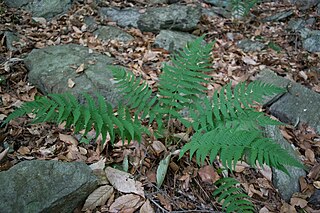
Dryopteris marginalis, vernacularly known as the marginal shield fern or marginal wood fern, is a perennial species of fern found in damp shady areas throughout eastern North America, from Texas to Minnesota and Newfoundland. It favors moderately acid to circumneutral soils in cooler areas but is fairly drought-resistant once established. In the warmer parts of its range, it is most likely to be found on north-facing non-calcareous rock faces. It is common in many altitudes throughout its range, from high ledges to rocky slopes and stream banks. Marginal wood fern's name derives from the fact that the sori are located on the margins, or edges of the leaflets.

Aspidotis densa is a species of fern in the Cheilanthoid subfamily, known by the common name Indian's dream or Serpentine fern or dense lace fern. It is native to the west coast of North America from British Columbia to California and east to the Rocky Mountains in Idaho, Montana, and Wyoming; there is a disjunct population on serpentine soils in Quebec.

Myriopteris gracillima, formerly known as Cheilanthes gracillima, is a species of lip fern known by the common name lace lip fern. It is native to western North America, where it grows in rocky habitat from British Columbia to California to Montana.

Lomatium cuspidatum is a perennial herb of the family Apiaceae, native to the U.S. state of Washington. It is found primarily on open rocky slopes in the Wenatchee Mountains, strongly associated with serpentine scree and soils.
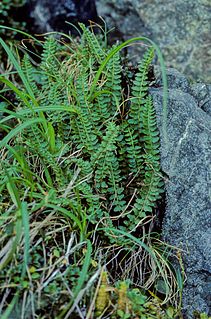
Polystichum aleuticum, the Aleutian holly fern or Aleutian shield fern, is an endangered species of the Polystichum genus and currently consisting of a small, vulnerable population endemic found only on Adak Island, Alaska, a remote island of the Aleutian Islands chain in the northern Pacific Ocean. In 1992, 112 specimens existed in the wild, and a recovery plan was implemented.
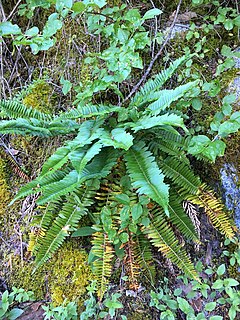
Polystichum imbricans is a species of fern known by the common names narrowleaf swordfern and imbricate sword fern. It is native to western North America from British Columbia to southern California, where it grows in rocky habitat in coastal and inland mountain ranges and foothills. This fern produces several erect linear or lance-shaped leaves up to 80 centimeters long. Each leaf is made up of many narrow, overlapping, sometimes twisting leaflets each 2 to 4 centimeters long. The leaflets have toothed edges. This fern readily forms hybrids, some of which are fertile and are considered separate species, such as Polystichum californicum, its hybrid with P. dudleyi.
Polystichum kruckebergii is a species of fern known by the common names Kruckeberg's sword fern and Kruckeberg's hollyfern. It is native to western North America from Alaska to Utah to California, where it grows in rocky mountain habitat in subalpine and alpine climates.

Polystichum lonchitis is a species of fern known by the common name northern hollyfern, or simply holly-fern. It is native to much of the Northern Hemisphere from Eurasia to Alaska to Greenland and south into mountainous central North America. It has stiff, glossy green, erect fronds and grows in moist, shady, rocky mountain habitats.

Polystichum scopulinum is a species of fern known by the common names mountain hollyfern and rock sword fern. It is native to much of western North America, and it is known from disjunct occurrences in eastern Canada, as well. It grows in rocky habitat, often in full sun. It is widespread but mostly found in small populations, and is noted to be most abundant on serpentine soils. This fern produces several erect, narrowly lance-shaped leaves up to 50 centimeters in length. The leaves narrow near the bases. Each leaf is divided into many lance-shaped or oblong leaflets up to 3 centimeters long. The toothed leaflets are sometimes twisted on their axes and overlapping.

Woodsia scopulina, common name Rocky Mountain woodsia, is a deciduous perennial fern in the family Woodsiaceae.
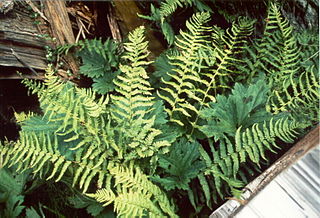
Parathelypteris nevadensis, synonym Thelypteris nevadensis, is a species of fern known by the common names Sierra marsh fern, Sierra wood fern, and Nevada marsh fern. It is native to western North America from British Columbia to the mountains of northern California, where it grows in moist wooded areas, streamsides, meadows, and seeps. It is known from two locations in Idaho, as well. Despite its name it is not found in Nevada, rather, it was named for the Sierra Nevada, where it does occur in the northern mountains. It produces a dense cluster of long, feathery leaves which may be up to a meter long. It is rhizomatous and it sometimes forms colonies. The leaves die back in winter. Each leaf is made up of leaflets lined with smaller segments. The undersides are glandular and resinous and sometimes hairy.

Adiantum viridimontanum, commonly known as Green Mountain maidenhair fern, is a fern found only in outcrops of serpentine rock in New England and Eastern Canada. The leaf blade is cut into finger-like segments, themselves once-divided, which are borne on the outer side of a curved, dark, glossy rachis. These finger-like segments are not individual leaves, but parts of a single compound leaf. The "fingers" may be drooping or erect, depending on whether the individual fern grows in shade or sunlight. Spores are borne under false indusia at the edge of the subdivisions of the leaf, a characteristic unique to the genus Adiantum.
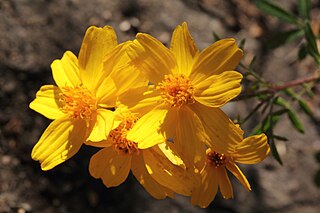
Tagetes lemmonii, or Lemmon's marigold, is a North American species of shrubby marigold, in the family Asteraceae. Other English names for this plant include Copper Canyon Daisy, Mountain Marigold, and Mexican Marigold.

Poa curtifolia is a species of grass found on serpentine soils in the Wenatchee Mountains of Washington State.

Polypodium amorphum is a species of fern with the common name irregular polypody, which grows near the northwest coast of North America.

Gymnocarpium disjunctum is a species of fern in the family Cystopteridaceae, commonly known as Pacific oak fern, western oak fern, or Pacific oakfern.

Myriopteris scabra, previously known as Pellaea scabra, Cheilanthes aspera or Cheilanthes horridula, is a species of cheilanthoid fern with the common name rough lipfern. It is native to Mexico and to Texas in the United States.
























